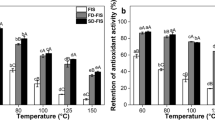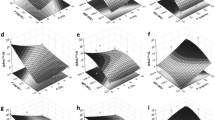Abstract
Osmoporation is an innovative method that can be used with food-grade yeast cells of Saccharomyces cerevisiae as natural encapsulating matrices. This technique overcomes barriers that difficult encapsulation and enables the internalization of fragile bioactive molecules such as fisetin into yeasts. In the present study, we assessed the effects of concentration, osmotic pressure, and temperature on the encapsulation efficiency (EE) and internalized fisetin content (IF). Two different quantification strategies were investigated: direct extraction (DE) without cell washing or freeze-drying steps and indirect extraction (IE) performed after washings with ethanol and freeze-drying. Our results showed that osmoporation improved EE (33 %) and IF (1.199 mg). The best experimental conditions were found by using DE. High-resolution images showed that the yeast cell envelope was preserved during osmoporation at 30 MPa and 84 % of yeast cells remained viable after treatment. Washing cells with organic solvent led to decreased EE (0.65 %) and IF (0.023 mg). This was probably due to either damages caused to yeast cell envelope or fisetin dragged out of cell. Overall, the results demonstrated the adequacy and relevant biotechnological potential of yeasts as encapsulating matrices for hydrophobic compounds. This fresh biotechnological approach has proven to be a promising tool for the production of bioactive-rich food products.




Similar content being viewed by others
References
Beney L, Marechal P, Gervais P (2001) Coupling effects of osmotic pressure and temperature on the viability of Saccharomyces cerevisiae. Appl Microbiol Biotechnol 56(3–4):513–516. doi:10.1007/s002530100619
Blanquet S, Garrait G, Beyssac E, Perrier C, Denis S, Hébrard G, Alric M (2005) Effects of cryoprotectants on the viability and activity of freeze dried recombinant yeasts as novel oral drug delivery systems assessed by an artificial digestive system. Eur J Pharm Biopharm 61(1–2):32–39. doi:10.1016/j.ejpb.2005.03.009
Box GE, Hunter JS, Hunter WG (2005) Statistics for experimenters: design, innovation, and discovery. AMC 10:12
Chirife J, Fontan CF, Scorza OC (1980) A study of the water activity lowering behaviour of some amino acids. Int J Food Sci Technol 15(4):383–387. doi:10.1111/j.1365-2621.1980.tb00953.x
Ciamponi F, Duckham C, Tirelli N (2012) Yeast cells as microcapsules. Analytical tools and process variables in the encapsulation of hydrophobes in S. cerevisiae. Appl Microbiol Biotechnol 95(6):1445–1456. doi:10.1007/s00253-012-4127-8
Coote P, Jones M, Seymour I, Rowe D, Ferdinando D, McArthur A, Cole M (1994) Activity of the plasma membrane H+−ATPase is a key physiological determinant of thermotolerance in Saccharomyces cerevisiae. Microbiology 140(8):1881–1890. doi:10.1099/13500872-140-8-1881
Davey HM, Hexley P (2011) Red but not dead? Membranes of stressed Saccharomyces cerevisiae are permeable to propidium iodide. Environ Microbiol 13(1):163–171. doi:10.1111/j.1462-2920.2010.02317.x
Dias MI, Ferreira ICFR, Barreiro MF (2015) Microencapsulation of bioactives for food applications. Food Funct 6(4):1035–1052. doi:10.1039/c4fo01175a
Dupont S, Beney L, Ritt J-F, Lherminier J, Gervais P (2010) Lateral reorganization of plasma membrane is involved in the yeast resistance to severe dehydration. Biochim Biophys Acta Biomembr 1798(5):975–985. doi:10.1016/j.bbamem.2010.01.015
Dupont S, Beney L, Ferreira T, Gervais P (2011) Nature of sterols affects plasma membrane behavior and yeast survival during dehydration. Biochim Biophys Acta Biomembr 1808(6):1520–1528. doi:10.1016/j.bbamem.2010.11.012
FDA (2015) Microorganisms & microbial-derived ingredients used in food. U.S. Food and Drug Administration. http://www.fda.gov/Food/IngredientsPackagingLabeling/GRAS/ Accessed 15 february 2016
Geraets L, Haegens A, Brauers K, Haydock JA, Vernooy JH, Wouters EF, Bast A, Hageman GJ (2009) Inhibition of LPS-induced pulmonary inflammation by specific flavonoids. Biochem Biophys Res Commun 382(3):598–603. doi:10.1016/j.bbrc.2009.03.071
Gervais P, Beney L (2001) Osmotic mass transfer in the yeast Saccharomyces cerevisiae. Cellular and Molecular Biology (Noisy-Le-Grand, France) 47(5):831–839
Gervais P, Marechal PA, Molin P (1992) Effects of the kinetics of osmotic pressure variation on yeast viability. Biotechnol Bioeng 40(11):1435–1439. doi:10.1002/bit.260401119
Jenkins GM (2003) The emerging role for sphingolipids in the eukaryotic heat shock response. CMLS, Cell Mol Life Sci 60(4):701–710. doi:10.1007/s00018-003-2239-0
Kechinski CP, Guimarães PVR, Noreña CPZ, Tessaro IC, Marczak LDF (2010) Degradation kinetics of anthocyanin in blueberry juice during thermal treatment. J Food Sci 75(2):C173–C176. doi:10.1111/j.1750-3841.2009.01479.x
Khan N, Afaq F, Syed DN, Mukhtar H (2008) Fisetin, a novel dietary flavonoid, causes apoptosis and cell cycle arrest in human prostate cancer LNCaP cells. Carcinogenesis 29(5):1049–1056. doi:10.1093/carcin/bgn078
Laroche C, Beney L, Marechal P, Gervais P (2001) The effect of osmotic pressure on the membrane fluidity of Saccharomyces cerevisiae at different physiological temperatures. Appl Microbiol Biotechnol 56(1–2):249–254. doi:10.1007/s002530000583
Lipke PN, Ovalle R (1998) Cell wall architecture in yeast: new structure and new challenges. J Bacteriol 180(15):3735–3740
Lyu SY, Rhim JY, Park WB (2005) Antiherpetic activities of flavonoids against herpes simplex virus type 1 (HSV-1) and type 2 (HSV-2) in vitro. Arch Pharm Res 28(11):1293–1301. doi:10.1007/BF02978215
Maher P, Akaishi T, Abe K (2006) Flavonoid fisetin promotes ERK-dependent long-term potentiation and enhances memory. Proc Natl Acad Sci U S A 103(44):16568–16573. doi:10.1073/pnas.0607822103
Marechal PA, de Marañon IM, Molin P, Gervais P (1995) Yeast cell responses to water potential variations. Int J Food Microbiol 28(2):277–287. doi:10.1016/0168-1605(95)00063-1
Naczk M, Shahidi F (2004) Extraction and analysis of phenolics in food. J Chromatogr A 1054(1–2):95–111. doi:10.1016/j.chroma.2004.08.059
Nobel JG, Barnett JA (1991) Passage of molecules through yeast cell walls: a brief essay-review. Yeast 7(4):313–323. doi:10.1002/yea.320070402
Normand V, Dardelle G, Bouquerand P-E, Nicolas L, Johnston DJ (2005) Flavor encapsulation in yeasts: limonene used as a model system for characterization of the release mechanism. J Agric Food Chem 53(19):7532–7543. doi:10.1021/jf0507893
Norrish RS (1966) An equation for the activity coefficients and equilibrium relative humidities of water in confectionery syrups. International Journal of Food Science & Technology 1(1):25–39. doi:10.1111/j.1365-2621.1966.tb01027.x
Panaretou B, Piper PW (1992) The plasma membrane of yeast acquires a novel heat-shock protein (hsp30) and displays a decline in proton-pumping ATPase levels in response to both heat shock and the entry to stationary phase. Eur J Biochem 206(3):635–640. doi:10.1111/j.1432-1033.1992.tb16968.x
Paramera EI, Konteles SJ, Karathanos VT (2011a) Microencapsulation of curcumin in cells of Saccharomyces cerevisiae. Food Chem 125(3):892–902. doi:10.1016/j.foodchem.2010.09.063
Paramera EI, Konteles SJ, Karathanos VT (2011b) Stability and release properties of curcumin encapsulated in Saccharomyces cerevisiae, β-cyclodextrin and modified starch. Food Chem 125(3):913–922. doi:10.1016/j.foodchem.2010.09.071
Park HH, Lee S, Son HY, Park SB, Kim MS, Choi EJ, Singh TS, Ha JH, Lee MG, Kim JE, Hyun MC, Kwon TK, Kim YH, Kim SH (2008) Flavonoids inhibit histamine release and expression of proinflammatory cytokines in mast cells. Arch Pharm Res 31(10):1303–1311. doi:10.1007/s12272-001-2110-5
Pedrini MRS, Dupont S, Câmara Júnior AA, Beney L, Gervais P (2014) Osmoporation: a simple way to internalize hydrophilic molecules into yeast. Appl Microbiol Biotechnol 98(3):1271–1280. doi:10.1007/s00253-013-5386-8
Pham-Hoang B, Romero-Guido C, Phan-Thi H, Waché Y (2013) Encapsulation in a natural, preformed, multi-component and complex capsule: yeast cells. Appl Microbiol Biotechnol 97(15):6635–6645. doi:10.1007/s00253-013-5044-1
Pham-Hoang N, Phan-Thi H, Wache Y (2015) Can biological structures be natural and sustainable capsules? Frontiers in Chemistry 3. doi:10.3389/fchem.2015.00036
Schaber J, Adrover M, Eriksson E, Pelet S, Petelenz-Kurdziel E, Klein D, Posas F, Goksör M, Peter M, Hohmann S, Klipp E (2010) Biophysical properties of Saccharomyces cerevisiae and their relationship with HOG pathway activation. Eur Biophys J 39(11):1547–1556. doi:10.1007/s00249-010-0612-0
Seguin J, Brullé L, Boyer R, Lu YM, Ramos Romano M, Touil YS, Scherman D, Bessodes M, Mignet N, Chabot GG (2013) Liposomal encapsulation of the natural flavonoid fisetin improves bioavailability and antitumor efficacy. Int J Pharm 444(1–2):146–154. doi:10.1016/j.ijpharm.2013.01.050
Shi G, Rao L, Yu H, Xiang H, Pen G, Long S, Yang C (2007) Yeast-cell-based microencapsulation of chlorogenic acid as a water-soluble antioxidant. J Food Eng 80(4):1060–1067. doi:10.1016/j.jfoodeng.2006.06.038
Shi G, Rao L, Yu H, Xiang H, Yang H, Ji R (2008) Stabilization and encapsulation of photosensitive resveratrol within yeast cell. Int J Pharm 349(1–2):83–93. doi:10.1016/j.ijpharm.2007.07.044
Simonin H, Beney L, Gervais P (2007) Sequence of occurring damages in yeast plasma membrane during dehydration and rehydration: mechanisms of cell death. Biochim Biophys Acta Biomembr 1768(6):1600–1610. doi:10.1016/j.bbamem.2007.03.017
Souza Pereira R, Geibel J (1999) Direct observation of oxidative stress on the cell wall of Saccharomyces cerevisiae strains with atomic force microscopy. Mol Cell Biochem 201(1–2):17–24. doi:10.1023/A:1007007704657
Stephens DJ, Pepperkok R (2001) The many ways to cross the plasma membrane. Proc Natl Acad Sci 98(8):4295–4298. doi:10.1073/pnas.081065198
Sundh I, Melin P (2011) Safety and regulation of yeasts used for biocontrol or biopreservation in the food or feed chain. Antonie Van Leeuwenhoek 99(1):113–119. doi:10.1007/s10482-010-9528-z
Tsong TY (1989) Electroporation of cell membranes. In: Neumann E, Sowers AE, Jordan CA (eds) Electroporation and electrofusion in cell biology. Springer US, Boston, MA, pp. 149–163
Weber FJ, de Bont JAM (1996) Adaptation mechanisms of microorganisms to the toxic effects of organic solvents on membranes. Biochim Biophys Acta Rev Biomembr 1286(3):225–245. doi:10.1016/S0304-4157(96)00010-X
Zandi K, Teoh BT, Sam SS, Wong PF, Mustafa MR, Abubakar S (2011) Antiviral activity of four types of bioflavonoid against dengue virus type-2. Virol J 8:560. doi:10.1186/1743-422X-8-560
Acknowledgments
Antonio de Anchieta Câmara Júnior was supported by Conselho Nacional de Desenvolvimento Científico e Tecnológico – CNPq grant 130133/2013-2. The authors are deeply grateful to Andrêsa Silva, to Brain Institute/UFRN (Brazil) and to LABTAM/UFRN (Brazil) for technical support during the microscopy manipulations.
Author information
Authors and Affiliations
Corresponding authors
Ethics declarations
Conflict of interest
The authors declare that they have no conflict of interest.
Ethical approval
This article does not contain any studies with human participants or animals performed by any of the authors.
Rights and permissions
About this article
Cite this article
de Câmara, A., Dupont, S., Beney, L. et al. Fisetin yeast-based bio-capsules via osmoporation: effects of process variables on the encapsulation efficiency and internalized fisetin content. Appl Microbiol Biotechnol 100, 5547–5558 (2016). https://doi.org/10.1007/s00253-016-7425-8
Received:
Revised:
Accepted:
Published:
Issue Date:
DOI: https://doi.org/10.1007/s00253-016-7425-8




